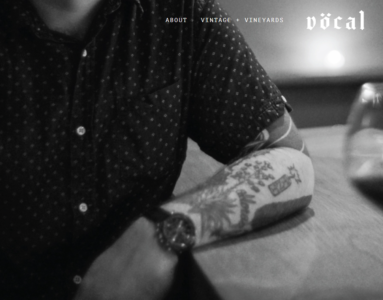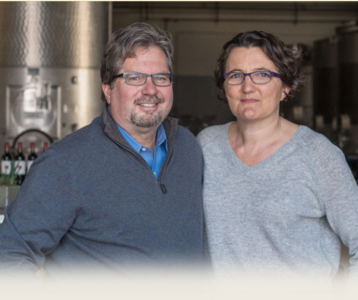- Gini 2021 Soave Classico (Garganega from the Veneto), $23
- Vocal Vineyards, 2019 Cabernet Pfeffer “Sabroso”, Enz Vineyard, San Benito County CA, $36
- Roagna 2022 Dolcetto d’Alba $33
- Domaine de Rochebin 2020 Bourgogne Blanc, $22
- Clefs des Murailles 2020 Vacqueyras $25
- Dashe Cellars 2018 “Les Infants Terribles” Grenache, Dry Creek ValleyCA, $29
———————– (3-bottle Option) ———————–
1. Gini 2021 Soave Classico, (Certified Organic) $23
The Wine
One of Northern Italy’s delicious, versatile and under-appreciated white wines. This is a wine that goes with damn near everything! (in my mom’s voice…”David! Language!”).
Soave wines are named for a region in Northern Italy’s Veneto. Soave wines exploded onto the budding American wine scene during the 1970/80s. Sadly, to keep up with demand, producers ‘cheapified’ their wines, reducing quality to increase production and meet growing demand. The wine’s popularity came to an equally expolosive end as US wine lovers discovered better quality wines. Soave sales remained dormant for the better part of a generation.
Fortunately for you and me, we’re alive during a period where a new generation of Soave winemakers have returned to the land, focusing on growing the best grapes possible so they can compete at the premium level instead of the bottom shelf of the grocery store.
2. Vocal Vineyards, 2019 Cabernet Pfeffer “Sabroso” Enz Vineyard, San Benito County CA (Organic) $36
The Wine
100% Whole Cluster Co-Fermented in concrete
8 days carbonic maceration
8 in barrel
~250 cases produced
The Enz Vineyard was originally planted in the 1890s and purchased by Bob and Sue Enz in 1967, this site is home to the Cabernet Pfeffer mother block. It’s origin is a mystery, but it is spicy and delicious. All vines here are own-rooted, organic and dry farmed in limestone. “Sabroso” is a Spanish word for “tasty”. Enjoy with a slight chill.
The Winery
“GREAT VINEYARDS HAVE VOICES THAT RESONATE WITH DEPTH AND CLARITY
Vöcal is about the natural tension in the vineyard between grape and ground, the sun and rain, the cellar and the hand of man. Each contribution is important. These are vineyards influenced by the deep, cold Monterey Bay. This deep upwelling of cold water results in a very windy, very chilly and very sunny coastal growing region.
All wines are made in a reserve style and will age with elegance.
Our vines are rooted deep in old soils, soaking in the brilliant California sunshine and leaning into the brisk bay winds; this is the voice behind Vöcal.”
Ted Glennon, Vocal Vineyards
3. Roagna 2022 Dolcetto d’Alba, Italy $33
The Wine
Piemonte enjoys an enviable, global reputation for its wines made from the Nebbiolo grape. Their world-famous Barolos and Barbarescos demand stunning prices from devoted collectors. These wines often appear on the lists at prestigious auction houses known for obtaining maximum value for collectors.
But all this attention on Nebbiolo has forced a handful of really great wines to play second fiddle. Each, in its own right, deserve their day in the spotlight. I speak of the forgotten stepchildren – Barbera and Dolcetto. We’ll consider Barbera another day, because this posting is all about a great wine made from Dolcetto!
Despite it’s name, the wine is not at all “Dolce” (sweet). It expresses the classic Italian Red Wine profile that leads with aromas of cherry and dark fruits, seasoned with spice and a hint of fine glove leather and finishes with a pleasantly bitter note. The wine’s lower alcohol makes it a great every-day wine. It’s likely to be the house wine at any outdoor cafe in Piemonte, especially if you’re in the Dogliani area, where it finds its highest expression.
Less showy than it’s regal sibling, Nebbiolo, Dolcetto is considered “the farmer’s daily wine” (a compliment, in my book!). It pairs well with cheese and salumi and other picnic fare, as well as pasta dishes, braized meats and winter stews.
This particular wine from Roagna is often ranked among the top Dolcetto wines by global tasting panels.
———————– (6-bottle Option, all of above, plus…) ———————–
4. Domaine de Rochebin 2020 Bourgogne Blanc, France $22
The Wine
5. Clefs des Murailles 2020 Vacqueyras, Rhone, France $25
The Wine
Swimming in the lane right next to the Rhone’s undisputed world champion, Chateauneuf-du-Pape (CdP), Vacqueras offers a similar profile at a lower price point. Let’s face it, CdP gets pricey, and most of us can’t afford to pull those corks on a daily basis. Vacqueyras allows us to enjoy a similar wine without tapping the home equity line.
Effusive, friendly, and giving, this wine can be described as ‘gregarious’! Fruit-driven and jammy, with lots of spice and sassafrass notes, lovers of Aussi Shiraz and Dry Creek Zins will eagerly add a case of this wine to their collection.
A word on the glass bottle – the molded impression above the paper is called a cartouche and is common on the wines of CdP, Vacqueyras and Cornas. Each region has its own centuries-old design and their use is regulated by the region’s wine laws. Frugal wine lovers can simply search for the Vacqueyras cartouche at their favorite wine shop to enjoy an affordable but still special wine.
We understand that desparation sometimes forces one to venture into the wine aisles of BevMo, Total Wine or (shudder) Safeway. Should you find yourself there, hidden by hoodie and dark glasses, you have our sympathies. We know that knowledgeable wine staff are rare and a call for assistance will be met by the sound of crickets. The unique Vacqueyras bottle design lights your way back to safety in the storm. If you can find one!
Critic’s Notes – “Rich, with a concentrated core of fresh and sappy cassis, black currant, licorice, rhubarb, eucalyptus and baking spice over warm earth. The mouthfeel is round, with a long-textured finish. Notes of red berries are sprinkled with crushed black pepper. An easy, winning match with barbeque. 90/100” Wine Enthusiast
6. Dashe Cellars 2018 “Les Enfants Terribles” Grenache, Dry Creek Valley $29
The Wine
This is one of the best-selling wines at our Alameda store!
The grapes for this wine come from Clarksburg, an area on the Eastern edge of the Bay area. Clarksburg has warm days but cool nights that help preserve the grape’s all-important acidity and aromatics. And Dashe takes advantage of Nature’s air conditioning by harvesting the grapes in the middle of the night. Though I can only imagine what it’s like to harvest by headlamp, it’s a necessary piece of the quality you find in this bottle. It’s the time of day wehn the grapes are at their coolest and have constricted into a tight, self-preservation mode that maximizes acidity and aromatics.
The grapes are then transported to the winery in a cold container so they arrive, an hour or two later, in just-picked condition. Here the pressing occurs and the juice is fermented using native yeast inside a massive oak cask. The large wooden vessel allows for a slow maturation without imparting overt oak influence. The resulting purity of flavor, velvety texture, and lush midpalette provides a break from the brash, fruit-forward style of many Californian Rhone-Style wines.
The wine’s first impression is made by it appearance in the glass. Look for a surprisingly pale red relative to Grenache grapes from warmer climes using longer macerations. Its aromas bring red fruits – fresh strawberries and pomegranate – followed by notes of sweet spices and wet stone. The wine offers a pleasant, velvety texture and strawberry, raspberry, and pomegranate fruit. Additional complexity is contributed by floral notes of lavender and violets. The wine ends with long, and pleasant finish of red fruit, minerals and a peppery spice note.
“91/100” Wine Enthusiast
The Winery
Dashe Cellars is an urban winery that inhabits a large facility on what was once the Alameda Naval Air Station. I can’t think of a better use for that space.
The husband and wife team of Michael and Ann Dashe (Right) started Dashe Cellars in 1996, and have developled a devoted following among locals and visitors alike. But their grapes aren’t urban at all. In this case, they hail from Sonoma’s Dry Creek Valley (not so aptly named, during years when rainfall is heavy it would better be called “Flooded Creek Valley“… but I digress). Perhaps best known for its Zinfandel wines, Dry Creek Valley is also home to some of California’s best Rhone varietals.


